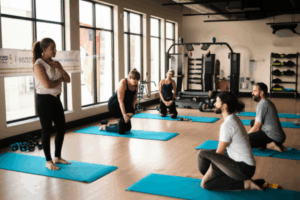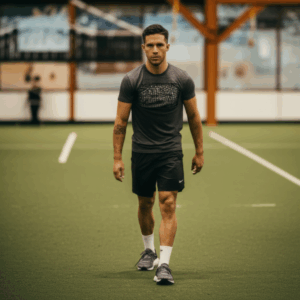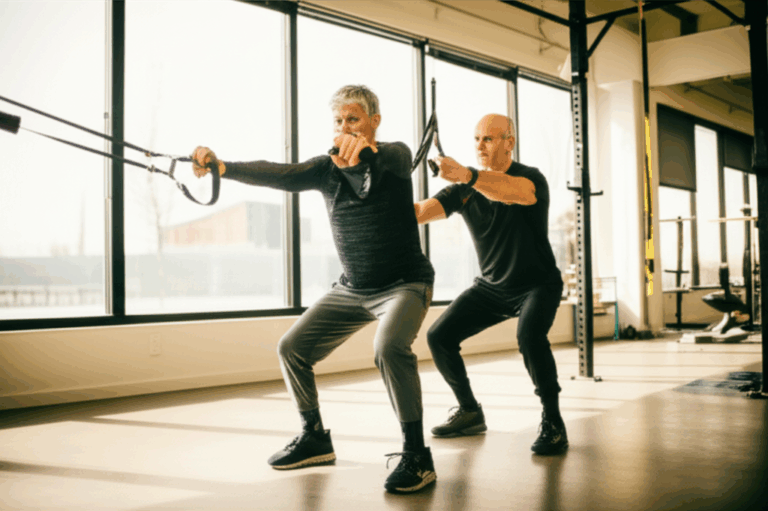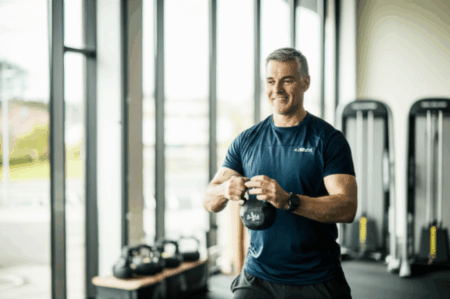The idea that a 12-minute morning routine can build more strength than a 45-minute gym session, especially after 40, is rooted in the principles of efficient, high-intensity training. As we age, maintaining and building muscle becomes increasingly vital due to sarcopenia, the natural decline of muscle mass that can start as early as your 30s. However, this doesn’t necessitate lengthy gym sessions. Short, targeted workouts, particularly those incorporating compound bodyweight movements, can be incredibly effective.
This article will explore the science behind these efficient routines and provide a sample 12-minute morning workout designed to maximize strength gains for individuals over 40, all without the need for expensive gym equipment.
As the years tick by, many of us find that maintaining fitness isn’t as straightforward as it once was. After 40, muscle mass naturally begins to decline, a process known as sarcopenia, which can impact metabolism, joint health, balance, and the ability to perform daily tasks. The good news? You don’t need to commit to grueling, hour-long gym sessions to combat this. Research and expert opinion suggest that short, intense, and strategically designed bodyweight routines can be remarkably effective for building and maintaining strength, even outperforming longer, less focused workouts.
This isn’t just about saving time; it’s about training smarter. Long workouts can lead to increased cortisol levels and slower recovery in older adults, potentially hindering progress. High-intensity interval training (HIIT) principles, when applied to strength training, can provide significant benefits in a fraction of the time, improving both strength and endurance. Even brief bouts of resistance exercise have been shown to boost muscle function and support long-term health.
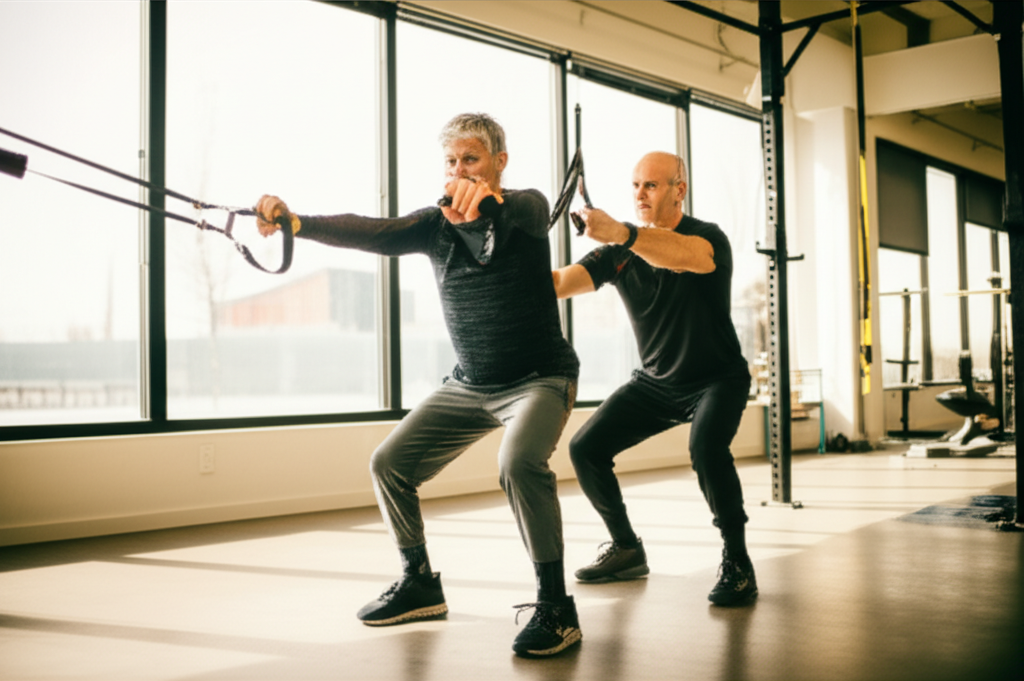
The Science Behind Efficient Strength Building After 40
Why do shorter, more intense workouts deliver such potent results, particularly for those over 40? The answer lies in how our bodies respond to different types of stimuli.
Combating Sarcopenia and Boosting Muscle Synthesis
Sarcopenia is a real concern, with muscle loss starting at a rate of about 3 to 8 percent after age 30. The best defense is to build and retain as much muscle as possible, and the best time to start is “now”. Short, frequent bursts of intense exercise stimulate muscle protein synthesis more effectively than longer, less intense sessions, especially when hitting muscle groups more often throughout the week.
The Power of High-Intensity Interval Training (HIIT)
HIIT involves short, intense bursts of activity followed by brief rest periods. This method is not just for the young; it’s highly beneficial for individuals over 40. HIIT can improve cardiovascular health, increase muscle strength and endurance, reduce the risk of chronic diseases, and even sharpen cognitive functions. It allows for greater fat burning during and after the workout due to elevated EPOC (excess post-exercise oxygen consumption). For instance, 20 minutes of HIIT can be equivalent to nearly 40 minutes of steady-state effort in terms of cardiovascular benefits.
Hormonal Response and Recovery
As we age, recovery from intense exercise slows, and hormonal shifts mean muscle repair takes longer. Long, moderate workouts can lead to elevated cortisol, a stress hormone that can promote fat storage, especially around the midsection. Shorter, high-intensity sessions keep intensity high without over-stressing the body, allowing for better recovery and consistent training.
Functional Strength and Joint Health
A well-designed short routine often focuses on compound, multi-joint exercises that mimic real-life movements. These exercises engage multiple muscle groups simultaneously, building functional strength crucial for daily activities and supporting overall mobility. They can also be adapted to reduce joint strain while still building muscle, making them ideal for older adults.
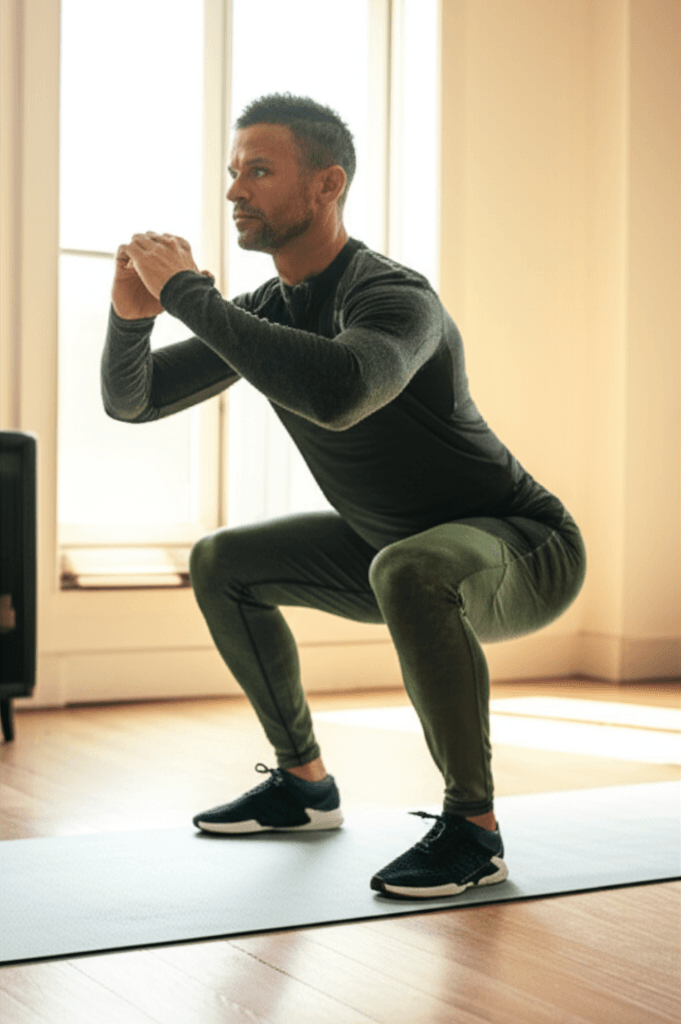
The 12-Minute Morning Strength Routine
This trainer-designed, equipment-free circuit focuses on hitting all major muscle groups and building functional strength quickly. Each exercise is performed for 45 seconds, followed by a 15-second rest, completing two full rounds for a total of 12 minutes.
Before You Start: Always begin with a brief warm-up (e.g., light cardio like marching in place, arm circles, leg swings) for 5-10 minutes to prepare your body and protect your joints.
The Exercises
Bodyweight Squats
- Why it’s effective: Squats are fundamental for lower body strength, mimicking daily movements like sitting and standing. They activate glutes, quads, and hamstrings, improving strength and circulation.
- How to do it: Stand with feet shoulder-width apart, toes slightly pointed out. Keep your chest lifted and core engaged. Push your hips back and bend your knees as if sitting into a chair. Lower until your thighs are parallel to the floor (or as comfortable, stopping if you feel pain). Drive through your heels to return to standing.
Alternating Lunges
- Why it’s effective: Lunges build unilateral leg strength, addressing imbalances and strengthening quads, glutes, and hamstrings. They also improve balance and coordination.
- How to do it: Stand with feet hip-width apart. Step forward with your right leg and lower until both knees are bent at about 90 degrees, keeping your front knee over your ankle. Push through your right heel to return to the starting position. Repeat on the left leg.
Push-Ups
- Why it’s effective: Push-ups are a classic upper-body exercise, building strength in the chest, shoulders, and triceps, and improving shoulder stability. They are highly adaptable and reduce joint strain compared to heavy bench presses.
- How to do it: Start in a high plank position with hands directly under your shoulders, body in a straight line from head to heels. Lower your chest towards the floor by bending your elbows. Press through your palms to return to the starting position. (Modify by performing on your knees if needed).
Glute Bridges
- Why it’s effective: These are excellent for strengthening the posterior chain—glutes, hamstrings, and lower back—which are often neglected. This helps improve posture and overall lower body power.
- How to do it: Lie on your back with knees bent and feet flat on the floor, hip-width apart. Press through your heels to lift your hips toward the ceiling. Squeeze your glutes at the top and hold for one to two seconds. Lower your hips back down with control.
Plank
- Why it’s effective: The plank is an isometric exercise that strengthens the entire core, including abs, back, hips, and shoulders. It supports better posture and spinal alignment.
- How to do it: Get into a forearm plank position with elbows under your shoulders. Keep your body in a straight line from head to heels. Engage your core, glutes, and legs, avoiding hip sagging or piking upwards.
Routine Structure:
- Bodyweight Squats: 45 seconds work, 15 seconds rest
- Alternating Lunges: 45 seconds work, 15 seconds rest
- Push-Ups: 45 seconds work, 15 seconds rest
- Glute Bridges: 45 seconds work, 15 seconds rest
- Plank: 45 seconds work, 15 seconds rest
- Repeat the entire circuit for a second round.

Maximizing Your Results After 40
While a 12-minute routine is highly efficient, remember these crucial tips for optimal strength building and overall health after 40:
Prioritize Recovery
Adequate sleep, proper nutrition, and mobility work are just as important as the workout itself. As you age, your body needs more time to recover.
Master Your Form
Good technique is paramount to prevent injury and ensure you’re effectively targeting the intended muscles. Never compromise form to lift more weight or do more reps. If you feel any pain, stop immediately.
Stay Consistent
Small, steady efforts consistently delivered will yield better results than sporadic, heavy lifting sessions that might lead to burnout or injury.
Focus on Progressive Overload
To continue building strength, you need to gradually increase the challenge. This can mean performing more reps, increasing time under tension, or introducing more challenging variations of bodyweight exercises (e.g., staggered hand push-ups, single-leg squats).
Incorporate Nutrition for Muscle Growth
A clean, consistent diet rich in protein, healthy fats, and complex carbohydrates is essential to support strength gains and recovery. Building muscle while burning fat is possible, but requires a strategic approach to protein intake and caloric balance.
By embracing this efficient, bodyweight-focused morning routine, individuals over 40 can effectively build and maintain strength, improve functional fitness, and combat age-related muscle loss, proving that quality often trumps quantity in the realm of fitness.


